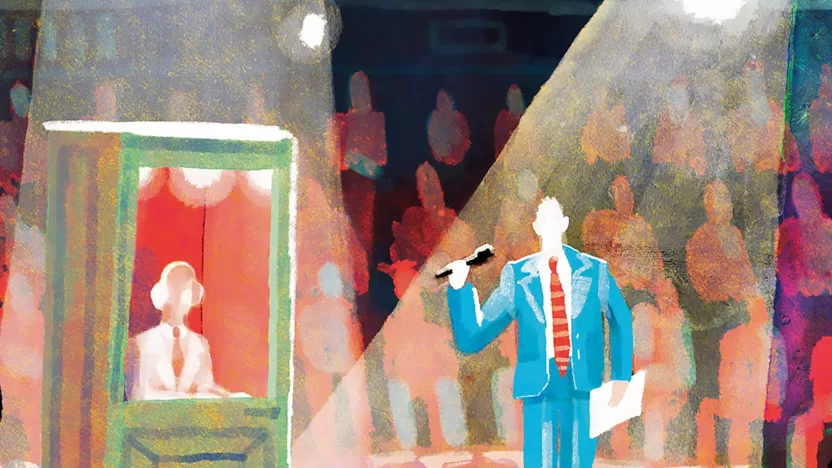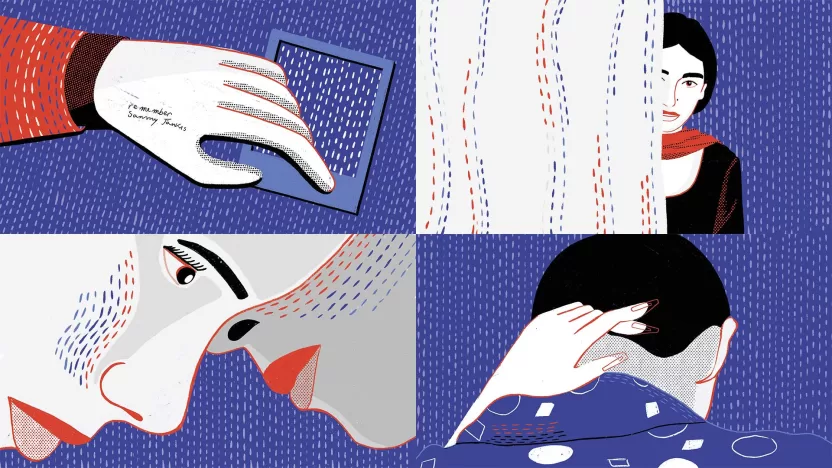Can we get rid of fake news?
With the right treatment, the mind of a conspiracist can be cured.
by Mick West

Illustration by Anna Parini
On 6 January 2021, several thousand people marched towards the US Capitol building, where the nation’s lawmakers were convened in a joint session to place the final seal of certification upon the recent presidential election. The individual states had already certified the results weeks earlier. Joe Biden had won, and Donald Trump had lost. The certification was essentially a formality, an opportunity for speeches and some minor procedural grandstanding that would only delay the inevitable result.
But the marchers did not see it that way. The protestors breached the windows of the Capitol, some scrambled in and opened the doors, and the world changed.
Freeze upon that moment. Consider the mass of people gathered around. A few score people made it into the inner sanctums. Nearly a thousand made it inside the building. Thousands more roiled around outside. They were all conspiracy theorists.
At the periphery were people who simply believed Trump’s false claims that the election had been stolen. But as you got closer and closer to the middle, the intensity of those beliefs grew. Many of those present believed communists were trying to take over. Many, if asked, would have told you that communists or perhaps the CIA had killed Kennedy. Few of them wore masks, firmly convinced that the Covid-19 pandemic was fake news. Some would have told you that 9/11 was plotted by the US government, or even that the moon landings were staged and the government was spraying us with mind-altering chemicals from planes.
At the very center were people like Jacob Chansley, the fur-and-horns wearing self-styled “QAnon Shaman,” Doug Jensen, the ‘Q’ emblazoned leader of the pack who chased a police officer up the steps, and the woman who died, Ashli Babbit, a former member of the US Air Force who ended her life a believer in the QAnon conspiracy theory. She died dressed like a superhero, a US flag backpack, a cape made from a Trump flag, her jacket covered with QAnon patches.
How did it get so far? How do people fall so deeply for bizarre conspiracy theories? Can we help them return to normalcy? Can we prevent them from falling for the theories in the first place? The key to helping conspiracy theorists is to understand their journey, their trajectory into and out of the rabbit hole.
Over the last fifteen years, I have talked to hundreds of people who were, and in many cases still are, conspiracy theorists. Conspiracy theorists are a varied bunch. It is very easy to dismiss a conspiratorial person as being simply paranoid and ignorant — a tinfoil-hat-wearing consumer of nonsense. But the people I have talked to, people who all had some flawed relationship with reality, covered the entire gamut of human existence. Rich and poor. Young and old. Highly educated academics and blue-collar workers. Stoics and madmen.
Yet out of this melange, a certain commonality has arisen. All these people were on an arc — a trajectory, rooted in circumstances, that pivots sharply around what many people, including the people involved, refer to as the “red pill” moment — a precipitous exposure to new information that opens their minds to a radically different world.
Ask a conspiracist about their red pill moment. They will generally know exactly what you are talking about and will almost always be able to tell you when it was.
Ask a conspiracist about their red pill moment. They will generally know exactly what you are talking about and will almost always be able to tell you what it was. Their red pilling remains in the forefront of their mind because it is the origin story in the movie of their life — a movie in which they play a hero. It is the event that prompted them to detour from everyday life, and as such, is both meaningful and memorable.
It is often (and with newer recruits, almost always) a video. A believer in the chemtrails conspiracy theory will tell you they watched What In The World Are They Spraying. Someone who started with JFK will mention Oliver Stone’s 1991 film JFK. A 9/11 theorist will relate how late one night, at the urging of a friend, they watched Loose Change or Zeitgeist. QAnon supporters will tell you which one of the many videos of Q “Proofs” woke them up to a new reality.
But how does this red pill work? These videos are out there on the internet, but few people watch them, and fewer still are convinced by them. What makes a person particularly susceptible to falling for nonsense? Academic research has been done, and certain psychological markers have been identified that somewhat correlate with an increased likelihood of being a conspiracist. A high score on the “need for uniqueness” test gives you a few percentage points, and you’ll get a few more for things like being open to new experiences, or prone to overestimating the likelihood of co-occurring events, or a propensity towards imagining intentionality where there is none.
These factors tell us little about the individual. While they might be significant in the aggregate, it’s generally meaningless to try to parse exactly how a person scores on measures that we all share to some degree. To help a person and to communicate with them, we need to understand where they are coming from. So as a more useful illustrator, I always ask the theorist to tell me what was going on in their lives leading up to their red pill experience. Stories vary, but themes emerge. Environmental factors seem to play a significant role. The most common combination is that they have too much time on their hands, and they were emotionally ripe for a new world view.
Having too much spare time can often come from some proximate event, often a life-changing one. They might lose their job, or graduate, or drop out of college. They might get a divorce or simply grow apart from their spouse as part of some mid-life crisis. They might have an accident or illness that confines them to bed. Or it might be that their surplus of free time is something that they have always had but had been filled until now with normal pastimes — watching television, or reading.
Then, other events and circumstances facilitate the red pill moment. Changes in their personal situation, like divorce or employment loss, might not only create more spare time and social isolation, but also a sense of anger and disappointment at the world and a search for a meaning that explains their current state. Major world events might shake their understanding of reality. Being on the losing side in an election will make them suspicious of the winners.
The Covid-19 pandemic has been a novel and significant factor here, one which doubtlessly played a part in radicalizing many of those involved in storming the US Capitol. It did this in three major ways. Firstly the lockdowns, working from home, and often unemployment made millions more people have too much spare time on their hands. Secondly, the global pandemic was a massively significant event, which encouraged the search for significant causes and appropriate guilty parties beyond the mundane reality of a mutated virus. Thirdly, authorities imposed public health measures, and many of the more libertarian conspiracy-minded folk reacted badly to this — questioning both the authority and the science and motivation behind the measures.
Beset by fertile circumstance, the unlucky proto-conspiracist drifts along towards the red pill launchpad. They might consume precursors to the red pill. Perhaps they look into a topic at the urging of a friend, or maybe they just happen across it while casually browsing. They become familiar with the material, perhaps even somewhat sympathetic, without really believing it to be real. And then it happens. They watch the video. They take the red pill. Everything changes.

Illustration by Anna Parini
The red pill is a gateway to a new reality. They watch the video and have a realization that everything that video is saying seems true. This conflicts with many things they thought they knew. So this sudden nugget of truth casts a positive and intriguing light on the new world and a pall across the old one. The trajectory begins. The period immediately following a red pill event is characterized by a gradual stripping away of trust in traditional information sources (the mainstream media, science, friends, and family) and a replacement with a new set of information sources (internet videos, alternative media sources, groups of like-minded people.)
This period is often described as “researching.” While a person is researching, they are constantly learning new things. These new things seem incredibly important, and the consumption of these important research products fills the conspiracist with a sense of importance and power. They know something other people do not. Something important. And they know where to find more such “knowledge.”
The post-pill research period is often the most challenging time to help someone out of the conspiracy theory rabbit hole. Their trajectory is steep, hurtling down into falsehoods and fantasy (or, from their perspective, up into reality). The constant discovery of new information acts as a pleasure-giving drug but also reinforces their new perspective and insulates them from contradictory information. Debunk one thing, and they will either move on to the next thing or reject your debunking because some new information coming down the pipe might just invalidate it.
This period of research lasts a long time. Sometimes years. It seems intractable. But I have talked to many former believers who once seemed impossibly lost and are now recovered. They also have a commonality: the reaching of a limit, a time of questioning, and a second awakening. And while they would not describe it as such, and the analogy with The Matrix does not really work, I describe this second pivot in their trajectory as the blue pill. A reawakening to reality.
The key to helping a person get to their blue pill moment as quickly and as smoothly as possible is to keep them as close to reality as possible while they are still on their post-red-pill deep dive.
The key to helping a person get to their blue pill moment as quickly and as smoothly as possible is to keep them as close to reality as possible while they are still on their post-red-pill deep dive. The core technique in this is simply to keep talking to them. If you can still have a conversation with someone, you might be one of the few solid links back to the real world they have. Your initial goal should not be to leap in with debunks and fact-checks but rather establish a solid framework for discussion that acknowledges their beliefs.
Keep in mind that, while you know they have been deluded by false information sources and are being frustratingly resistant to correction, they think exactly the same about you. From their perspective, you have been brainwashed by the mainstream media, and you are frustratingly ignoring all the amazing information they are trying to share with you. So carry out the discussion with respect for your friend. That does not mean that you have to pretend to agree with them, but rather that you acknowledge that they think they have valid reasons for believing the way they do.
Try to find out what those reasons are. Ask them why they have come to their conclusions. How did it start? How did it progress? What sources do they follow and trust, and what sources do they now distrust. How did they reach that decision? Then tell them the same things about yourself. Laying this foundation will do multiple things. It will help you understand them and so better address their concerns. Likewise, it will help them understand you. They will trust and respect you more simply because you listened to them and did not dismiss them out of hand. Lastly, the discussion will touch upon various key aspects of their beliefs to create a framework conducive to future debate.
The next stage is supplying helpful information. This is information that helps them see where they were wrong or misled. It might be specific fact-checks, debunking particular claims, or supplying a broader context that helps them realize that one aspect of a theory (or even the entire theory) does not actually make sense.
Supplying helpful information is always secondary to maintaining effective communication. If things start to get heated, back off, give it time, and approach from a different direction. Try to focus on parts of the theory about which they might not have entirely made their mind up. Everyone has a line on the spectrum of conspiracies where they think claims beyond that line are baseless nonsense. Beliefs just this side of that line will be less contentious and lead to more productive discussions.
Conspiracy theories, like cults, have evolved over the decades to incorporate ways of keeping a believer from reality. With a cult, the acolytes are separated from their families and taught to chant “thought-stopping” mantras if they sense any doubt. With conspiracy theories, similar aspects have naturally arisen in any long-lived theory. The belief structure fosters the idea of massive media manipulation with newspapers, television, and the internet, even extending into scientific journals. Distrust of the mainstream has evolved to the stage that it alienates them against anyone who gives the mainstream any credence at all.
QAnon is at the peak of the conspiracy theory evolutionary ladder. As well as epitomizing the effective use of the demonization of the mainstream media as an isolating tool, QAnon has developed a mechanism to avoid the blue pill moment. This was done by hooking the believers on a constant stream of new information. The “research” phase can never be complete since each day brings something new. This also significantly weakens the approach of discussing their beliefs, as any fact-checking is instantly submerged in the wave of new “proofs.”
While this makes QAnon uniquely challenging, it also burns out quicker. A constant stream of predictions, no matter how loosely worded, cannot help but accumulate many losses and disappointments over time. This is especially true when the focus is on a specific event, like the election of the US President. Many of the people who stormed the Capitol are now no longer believers in QAnon. But many still are. It takes time, but anyone, no matter how lost they seem, can eventually escape from the rabbit hole of conspiracy theories. We can help.


